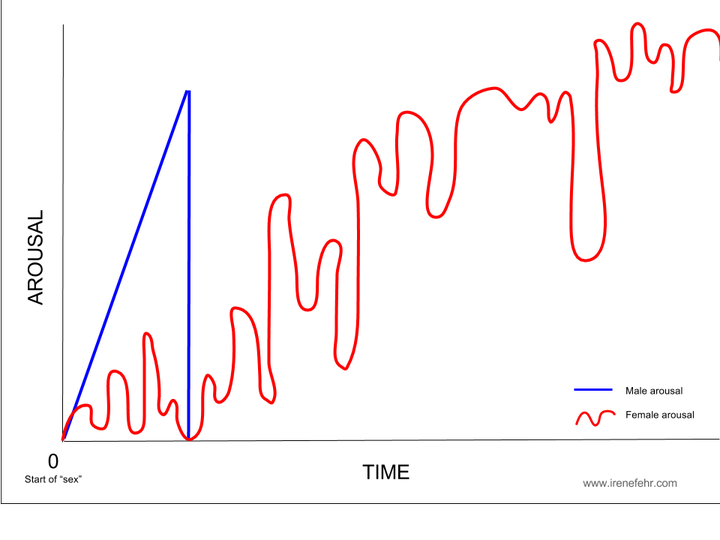
Into my late 20s, I found myself in a sexless marriage. After a passionate beginning, I had lost my libido. Gone. No sexual desire or even a fluttering in my genitals.
Feeling broken, I sought out ways to be fixed to look and act like I am supposed to: turned on, sexy, and wanting sex with my loving husband. I went to gynecologists, therapists and a variety of medical doctors who, maybe, hopefully, could point me towards a cure. Having an answer would mean I was fixable, that I could get back to normal.
But the answers I got — the answers of a science solely based on men — were not what I wanted to hear. “It’s normal for women to lose interest in sex in a committed relationship.” “Some pain during sex is normal.” “You’re fine medically and maybe you just don’t have a libido.”
Feeling dejected, I shut down, pulling away from my husband. In this tender place where we both needed each other’s support and love, our mutual silence tore us apart through shame, resentment and fear.
It was not until five years after my divorce — the inevitable next step from having lost the physical and emotional connection that had bound us in the first place — that I learned the truth that liberated my sexuality and paved the way for a fulfilling and nourishing sex life.
The truth that female sexuality runs differently than a man’s. And that is OK.
It was this insight and the advice to embrace it that helped me not only learn to enjoy sex, but also how to deepen sexual and emotional intimacy in a romantic relationship.
Although there are women who face legitimate difficulties with certain aspects of sex (e.g., lubrication, pain, orgasm), more often than not there is nothing wrong with women’s bodies. With the dearth of information pertaining to women’s arousal and its complexity, it’s easy for women to decide, erroneously, that they might be broken.
Female libido is simply different. A woman’s openness and desire for sex is highly dependent on her body’s arousal, or the process of getting turned on.
And that process is responsive (as opposed to spontaneous) to multi-level stimulation (physical, mental, psychological and emotional) as well as to the level of safety she feels around not being obligated to do something against her desire. When a woman is stimulated in the way that feels good to her and is on her terms (e.g., where she feels safe that her body, emotions and speed will be honored) and when she is paid attention to in a loving and caring way, she can become aroused. When she becomes aroused, her desire for sex emerges.
Her arousal is also non-linear. It’s undulating and wavering. It’s OK to have down times. Like a wave cresting then falling and building itself back up again, her arousal’s ups and downs are not signs of her brokenness, but of her body’s cyclical nature. It’s OK to experience a wide range of emotions during sex — from sadness and anguish to erotic bliss. In the end, her arousal has the potential to go high and long, if allowed to go at its natural pace.

Generalized arousal curve for women and men
When a woman honors her arousal process, it creates a virtuous cycle: When she feels safe to enjoy the stimulation and gets filled up on it, she becomes aroused. At which point, her desire emerges and becomes spontaneous as she becomes wanting, willing — and physically able — to share it with her partner. Her body wants sex, and fueled by desire, she is able to let herself go into deeper play, engagement and surrender (and orgasm) with her partner.
As a sex coach who works with women and couples around female sexual desire, I also see the vicious cycle play out in my clients.
It’s almost predictable: Pressured to meet her male partner’s arousal curve, the woman goes into penetration sex before she is fully aroused and she ends up not enjoying it, she often doesn’t speak up or is not met in her requests and she grows resentful; she wants less of any kind of sexual stimulation, she doesn’t speak up in fear of hurting her partner’s feelings but withdraws nevertheless; he starts demanding more sex or ends up withdrawing in his own shame. As the disconnect grows, the trust and the connection diminishes between the couple, further reducing her desire for sex and often increasing his demands.
This vicious cycle poisons the relationship with shame, fear and lack of trust, undercutting the intimacy and care the couple deeply need to connect sexually.
This pattern can be interrupted when couples understand the differences in sexual arousal and learn to approach these differences with curiosity, compassion and opportunity — not only to meet each other’s needs, but to expand what’s possible in sex with more play, nourishment and connection that her higher arousal brings about.
One couple I worked with, a man and a woman in their early 40s, struggled with mismatched libidos and finger pointing. She accused him of being obsessed with sex. He accused her of not wanting him at all. That’s is hardly the case today. In understanding and working with their different arousal patterns, they learned to expand her arousal and how to ride the waves of the experience. To this day, she prefers sex in the mornings almost every day.
This is the advice that I wished I’d known when I was married. Understanding my own arousal and its needs reframed all the times I felt guilty about needing time for my body to become aroused or broken not being able to reach orgasm (which I never could in my marriage). It helped me see how asking for slower touch was my way to attune to what my body needed and activate the senses. It explained why I wasn’t just turned on in my relationship.
It helped me see how I didn’t know how to come forward vulnerably and ask my husband for what I needed — building intimacy in the process — and instead I pulled away and went silent.
It explained why sex was painful for me, and how I allowed penetration before my body was ready (and before the cervix tilts upward as the vagina and uterus become engorged and push it up). It explained why I didn’t enjoy sexual touch right off the bat (sexual touch for women becomes pleasurable as arousal rises). And it helped me access self-compassion for all those times I felt broken and inadequate and retreated in shame.
Most critically, it helped me find what does work for my body and sexuality and access the kind of turn-on that nourishes and fulfills me — feeds sexual connection in my romantic relationship. The turn on that feels energizing and freeing — and deeply nourishing.
What we often see in the movies — a woman’s spontaneous desire to jump into sex — is also what we often experience at the start of a relationship. Neither are fake. What contributes to women’s high sexual desire in the beginning of a relationship is precisely that she is being stimulated by her wooing partner with attention, emotional connection, and goal-less physical touch such as spontaneous kissing, make-outs and cuddles — and that sets off her desire.
It takes the same kind of activities to spark a woman’s sexual desire in a long-term committed relationship: explorative touch that doesn’t obligate her to sex, spontaneous connection, dedicated time alone with each other, and the emotional safety that lets her know that it’s OK to be exactly how she is.
When a woman understands her own body and its arousal and honors it with approval, she can access the magic her body and sex can provide. When a couple can see challenges around sexual desire as an opportunity for discovery, growth and expansion, they can access the deeper intimacy of fulfilling, nourishing and orgasmically-blissful sexual connection.
.........................
Join my free online live call and Q&A “Understanding Female Libido: What Couples Need to Know to Have Radically Fulfilling Sex” on November 15, 2017 at 5pm PST/8pm EST. On this call geared towards women, men and couples, you’ll learn about the female arousal curve, what helps stoke arousal and what kills it, and what women and their partners can do to create more spontaneous sexual desire. Check out various free training videos on my YouTube channel.